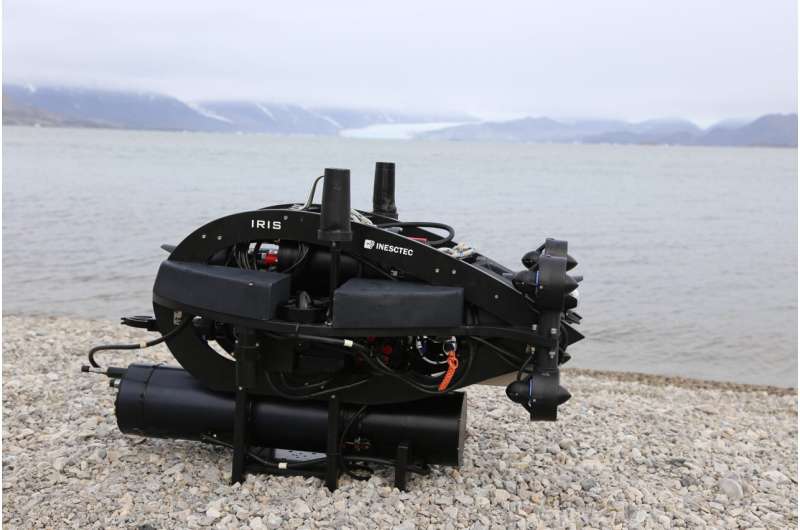
What if there was a way to collect environmental DNA (eDNA) samples in extreme environments autonomously? And what if this method allowed the collection of more samples and to prevent risk of sample contamination? Portuguese researchers from the Institute for Systems and Computer Engineering, Technology and Science (INESC TEC) set out to carry out this endeavor in the remote Arctic and Atlantic North environments.
The operation was carried out at a depth of 15 meters, in waters with low temperatures from melting glaciers located in the fjords of the Arctic Archipelago of Svalbard. How? With an innovative autonomous biosampler, a technology developed by Portuguese researchers at INESC TEC and the Interdisciplinary Center of Marine and Environmental Research (CIIMAR), capable of collecting planktonic communities (critical role in marine ecosystems) of different size fractions in situ.
The biosampler, a sensor shaped like a cylinder programmed to collect samples, was coupled to IRIS: an autonomous underwater vehicle (AUV), developed by INESC TEC, that can find its way underwater using acoustics and Artificial Intelligence. This cooperative use of a sampler and an AUV presented an “engineering challenge,” and allowed the autonomous collection of samples by researchers, at different stations of the monitoring program.
“This method has several benefits, particularly when compared to traditional collection methods, which are manual and involve collecting samples in Niskin bottles—the contents of which are filtered only in the laboratory,” explained Alfredo Martins, a researcher at INESC TEC.
INESC TEC’s researchers are now developing solutions to integrate the small and compact biosampler system with multiple robotic systems and expanding its capabilities and functionalities. However, this successfully achieved integration opens new possibilities for sample collecting: from scheduling collection times and dates to the gathering of a greater number of samples, or the reduction of contamination errors (since the filtration is done on-site). The automatization of the collecting process is also more cost-effective.
Next stop? 1,000 meters depth
The water was collected at Kongsfjorden, and the INESC TEC researchers carried out their work at the Ny-Ålesund Research Station (Norway), the northernmost research station in the world. The sampling being conducted in this region can provide valuable insights about marine microbial communities in that part of the globe: a single sample containing eDNA can be used to monitor biodiversity, detect climate change effects, or alert to the presence of threats like pathogens. That’s why a detailed analysis of marine microbial communities in that part of the globe is essential: the Arctic is experiencing some of most drastic changes in our planet and warming nearly four times faster than the rest of the world.
“To collect eDNA, it is technically more difficult to obtain this information at great depths; so obtaining it can fill relevant gaps in our knowledge of the deep ocean,” clarified Alfredo Martins and Ana Paula Lima, also a researcher at INESC TEC.
This innovative Portuguese technology developed by INESC TEC and CIIMAR can operate up to 150 m. The team of researchers who traveled to the Artic (Alfredo Martins, Ana Paula Lima, Carlos Almeida, Francisco Carneiro, José Miguel Almeida, and Pedro André Silva) set a two-year goal of operating this technology at a depth of 1,000 meters.
Overcoming the pressure
The main obstacle on the path to achieving this goal is—besides the pressure caused by the depth of the ocean—”the harshness of the environment itself, together with the difficulties in operating or maintenance limits.” “This requires enormous reliability from the systems so that they can operate correctly and autonomously, potentially for long periods,” added Alfredo Martins.
This Portuguese technology traveled to the Artic within the scope of the Connect2Oceans and MicroArtic projects. The main goal of this project is to understand how the progressive increase in Atlantic Water heat inflow to the Arctic, the so-called “Atlantification,” will promote shifts in Arctic plankton communities (these are the basis of life in marine environments), microbiome diversity and functions. These extreme polar environments will continue to be the testing sites for the biosampler.
Provided by
INESC Brussels HUB
Citation:
Scientists collect eDNA samples in the extreme environment of the Arctic melting glaciers autonomously (2024, January 9)
retrieved 9 January 2024
from https://phys.org/news/2024-01-scientists-edna-samples-extreme-environment.html
This document is subject to copyright. Apart from any fair dealing for the purpose of private study or research, no
part may be reproduced without the written permission. The content is provided for information purposes only.

